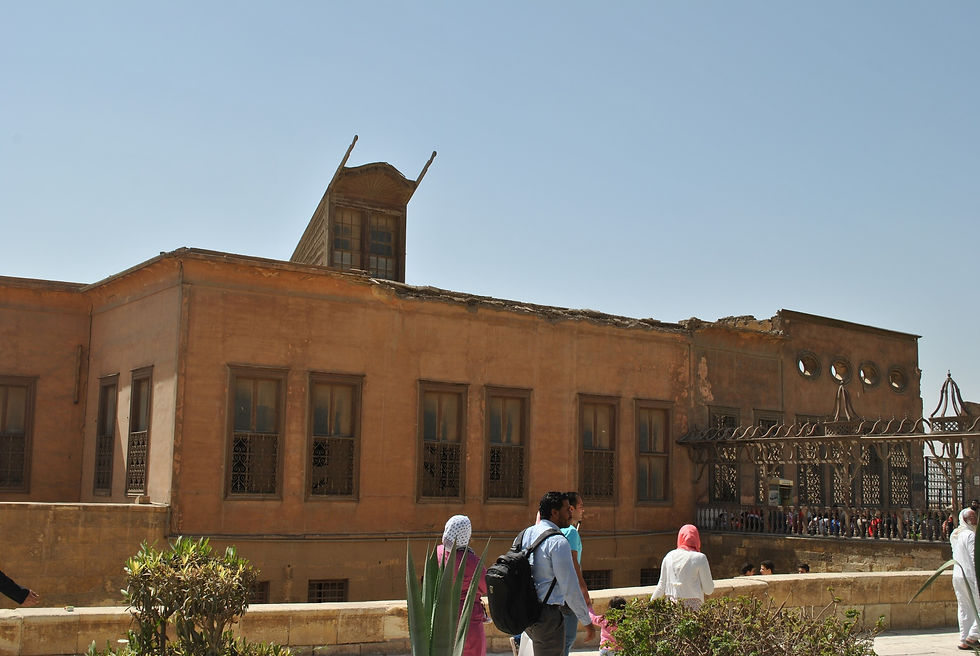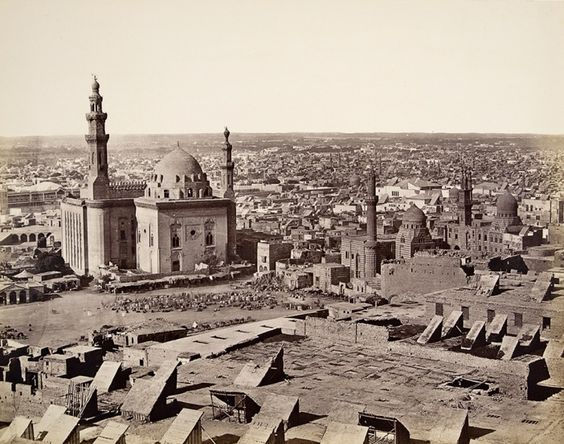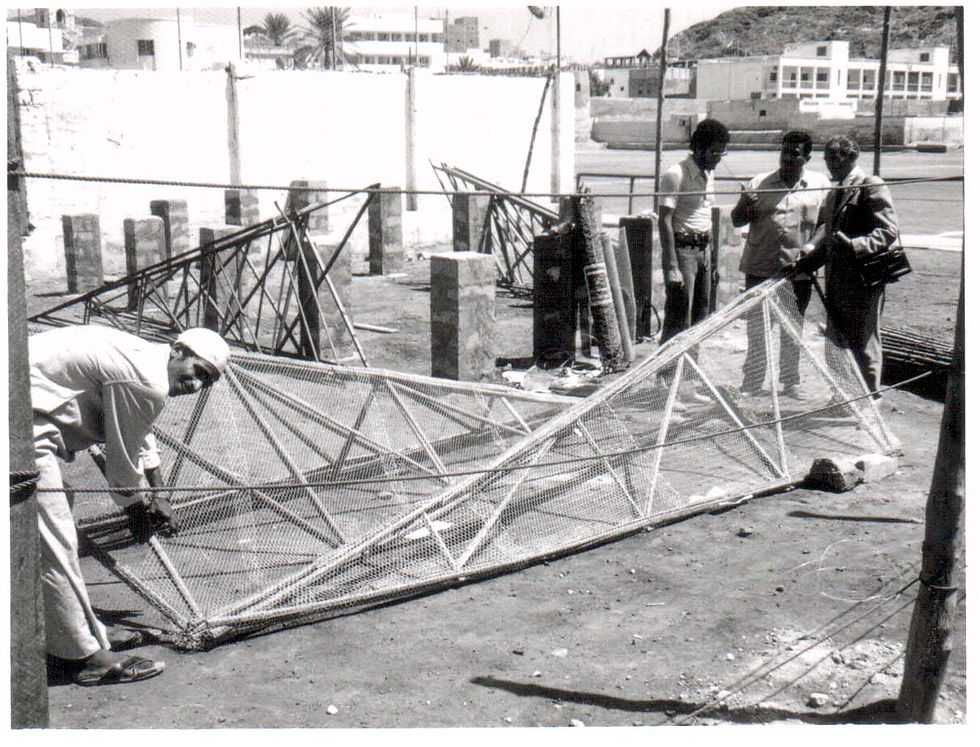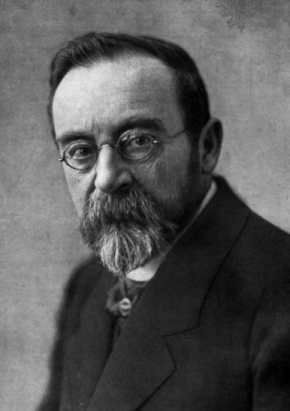
While many ascribe the introduction of the Malqaf in Egypt to the Arabs, Mulqaf is in fact an Egyptian architectural feature known and depicted in Egyptian drawings since the middle kingdom.1
Drawing dated back to the time of french aggression and looting of Egypt
In the language ϧⲉⲛ ϯⲁⲥⲡⲓ

This determinative is dedicated to the sail.. the sail of the ship.. anything related to the winds is allocated to it.

The second means that this is a human intervention; someone came and changed the course of the wind or let it flow into a place that it is not supposed to enter in its natural course
"Unfortunately, I did not find an explicit mention of the wind catcher, meaning their name is clearly like this.. but I found the verb.. the act of ventilation itself or venting. To breathe is Senfa in Egyptian, and according to the Etymology, the easiest way to derive the subject's name from the verb.. by not derivating at all, meaning when Senfa means to breathe. .. then Senfa is ventilation itself, or the hole that brings in the air of breathing. This is different from the window .. the window has another independent name"1

Vignette: The deceased holding a sail, symbolic of air. Quelle: Coming forth by the day light

صورة مصاحبة ل فصل: كلمات من أجل الحياة والتنفس في العالم الاخر
ترجمة. شريف الصيفي

Refering to the favourable northern winds in different positions in the book of coming forth by day light 229

"I am a follower of Thoth and I am happy with what I have accomplished. I bring you fresh air to your nose.
Life and health for you and for your beautiful face.
To whom the north winds comes out from Atum's nostrils"
In today's Egypt we say when we feel fresh air touching our faces gently " some air that brings the soul back"
I cam recently across a study of CH161 book of Going forth by the day light. This is interesting if we consider that we are dealing with the dead as if he went to the new house. I will leave a picture of the text here to comment on it later. of course the name and auother of the study is mentioned.

Opening here is named Wb3 .
This will be explained more with translation
Design
The performance of the windcatcher depends on the position, orientation and size of the inlet and outlet opening in relation to the wall ratio. 5

Im Gegensatz zum Windturm hat der Windfänger nur eine Öffnung, welche in Richtung des vorherrschenden Windes eingeplant ist. Es wird ebenso wie der klassische Windturm genutzt, um kühlere Winde oberhalb des Gebäudes einzufangen und in das Gebäude zu leiten.
The size of Mulqaf is determined due to Temperature*
The size of a Malqaf is determined by the external air temperature. A larger size is required where the air temperature at the intake is low, and a smaller size where the ambient air temperature is higher than the limit for thermal comfort provided that the air flowing through the Malqaf is cooled before it is allowed to circulate into the interior. In Iraq, where the air temperature in summer rises to 45°C (113°F), the typical Malqaf shaft is very narrow. It is placed in the northern wall with a small inlet allowing the air to cool before it flows into the interior, as illustrated in figure 54. This is very similar to the shape of human nostrils, which are narrower in colder countries so that cold air will not reach the lungs before it has been heated by contact with the trachea, which is at body temperature.
Performance
The performance of the windcatcher depends greatly on the position, orientation, and size of the inlet and outlet opening in relation to the wall ratio. 5
The best arrangement for getting maximum airflow pattern into the space is to make the Malqaf inlet and outlet as large as possible. A comparative matrix was created listing air change rates calculated for the different model settings. In planning for the Malqaf, it was observed that the Malqaf position, orientation, inlet shape, shaft height, and outlet opening are some of the main factors in controlling wind environment. It is found that for summer cooling in low-rise housing using the Malqaf has the advantages of higher values of air change rates and higher air velocities over ordinary flat-roof buildings with windows, which leads directly to keeping spaces more comfortable
Von Vorteil ist beim Malqaf auch seine Kleine Oberfläche. Er ist damit viel kleiner als die Fassade es Gebäueds und verringert somit auh das Abshirmen der anderen Malqafs (6)
Die Größe wird hierbei von der Außenlufttemperatur bestimmt. Ist die Temperatur am Einlass niedriger so muss der Malqaf größer und bei Temperaturen die höher als annehmbar empfunden werden, muss er keliner dimensioniert sein.
Furthermore, we read more about the orientation of the opening and their presumed shapes in the work of Alexander Badawy, where A.B. try to reconstruct the architectural elements through his drawings and words.
A.B. Works to be added. ,,,,
Forms and their Development

" Surveying the field, already prepared in the archaic period, one finds that architects had mastered the main problems of housing. The habitation is always facing North. The devices invented show a practical sense to meet requirements......
the ventilators (ar. Mulqaf) opening in the ceiling of the ground floor rooms to ensure a cool North breeze..."


'This system of ventilation was not invented by the Arabs. It was known to and applied by the Egyptians. as found in the houses of Tell el-Amarna and as represented in the wall paintings of the tombs of Thebes...
It took the Egyptian architects all the time from the house of Neb-Amun of the XIX dynasty (1340B.C.) to the Qa'a of Muhibb al-Din (1350 A.D.) to develop the Malqaf and bring it to the degree of perfection it attained in this last example.'[3]
Different forms and locations acording A.B. Reconstruction

The bedrooms and living rooms face north and were probably ventilated through roof ventilators. p24

The bedroom is characterized by a raised alcove, which encloses the bed at its south end and is most probably ventilated by means of a semicupola, opening northward on the roof. p24
Revival

The very first design of the Egyptian Malqaf was and still a part of the historical buildings of cairo to the day

Egyptian roofs covered with traditional Mulqafs,1857 - 1859

Hassan Fathy was the one who tried to work with it further and play with its posibble varients in house of Father Aghabius of the coptic catholic church Designed By H.F Reusing the Egyptian ventilation technology found in the house of Neb Amun. Up in fine lines we can see H. copying house of Neb.Amun
A direct graphic reference relates these angles to a set of malkafs that appear on a private house in an ancient Eyptian wall painting. which is sketched by Fathy in the margin of one of the drawings.

H.F. using Barasti trusses for first time in a project in Sohar, Oman
"Fathy was commissioned by the Sultan of Oman to help to plan the redevelopment of the central commercial area of the port city of Sohar.
This market, which was to be built in several stages, was to be located near the shoreline and was designed to benefit from the almost constant breezes from the water toward the land.

Divided into sections related to the items for sale, this market was based on a 3.60 metre module, to be covered exclusively by barasti trusses. Fathy felt that this new adaptation of a traditional roof covering was more appropriate to the region, inexpensive to build, and more effective in gathering and funneling the sea breezes into the shops. The alternating wedges of the barasti truss roofs arranged on top of the commercial spaces give the long, linear market a lightweight and almost sail-like aspect when seen from the seaside which is very sensitive to its location."9
'

Thus some of the traditional function elements of vernacular architecture may enrich the otherwise bare products of modern architecture''
[1]1 Seqnenra
A history of Egyptian architecture V II,
The achievement of domestic architecture- A brief history of Egyptian architecture [2]Architectural Provision against Heat in the Orient, Alexander Badawy
[3]The Qa'a of The Cairene Arab House: Its Developments And Some New Usages For Its Design Concepts. International Colloquium On The History of Cairo. Cairo: 1970. Hassan Fathy Archives. Aga Khan Trust for Culture. Geneva, Switzerland.
[4]Philipp Vandenberg, Eine archaologische Biographie, Nofretete
[6] Marc Fester, Sabine Kraft, Nikolaus Kuhnert, Günther Uhlig: 88Arch+: Zeitschrift für Architektur und Städ¬tebau. Arch Verlag GmbH 1987
[7] Rossi, Cesare, and Flavio Russo. Ancient Engineers‘ Inventions: Precursors of the Pre- sent. Springer, 2017
Genius Loci, Band 9: Hassan Fathy, Bearbeiterin:Chiara Schmidt
* Air movement by pressure differential by Hassan Fathy
Hassan Fathy experimental barasti (date palm frond stem) roof before collapse
https://dwarchive.com/archive/hassan-fathy-experimental-barasti-date-palm-frond-stem-roof-collapse
99 Steele, James. 1989. The Hassan Fathy Collection. A Catalogue of Visual Documents at the Aga Khan Award for Architecture. Bern, Switzerland: The Aga Khan Trust for Culture, 55
https://www.archnet.org/sites/2595
Doaa Selim Mohamed Selim, Publication and Study of Chapters no. (159 -161-163) Of The Book of the Dead According to papyrus (JE.99067) in the Cairo Museum (A linguistic and comparative study) A research for Acquiring the Master Degree In Egyptology
Draft . Ich fürchte unsere Kenntnisse der ägyptischen Geschichte sind nicht viel besser, als wenn jemand von der neueren Geschichte Frankreichs aufgrund einiger Daten und Namen sich folgendes Bild machte: Eine alte Dynastie umfaßt die Könige von Ludwig XVI. bis auf Louis Philippe. Der erstere war ein Zeitgenosse Friedrichs des Großen. Daneben regierten drei Gegenkönige, die durch ihren Namen Napoleon sich schon als einer anderen Familie angehörig zeigen und auch einen anderen Titel tragen. Der erste scheint in Deutschland krieg geführt zu haben, der dritte muß ein bedeutender Herrscher gewesen sein, da er viele Bauten hinterlassen hat. - Adolf Erman 31 October 1854 – 26 June 1937

While holding in mind that what we didn't find does not mean that it did not exist, and with the words of Erman in consideration, we can view some of the reconstruction works of A.B. that shall be of great value in the revival of the Egyptian architecture













Comments